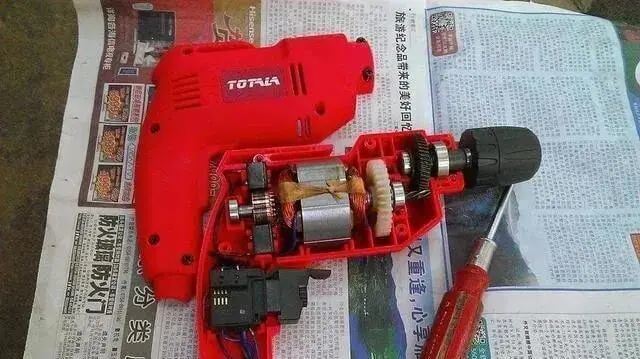Conteúdo da página
AlternarWhy do power tools generally use brushed motors instead of brushless motors??
Why do power tools (such as hand drills, angle grinders, etc.) generally use brush motors instead of brushless motors? To understand, this is really not clear in a sentence or two.

motores DC are divided into brush motors and brushless motors, and the “escovar” mentioned here refers to carbon brushes. What does a carbon brush look like?

Why do motores DC need carbon brushes? What is the difference between carbon brushes and no carbon brushes? Let’s read on!
DC brush motor principle
As shown in Figure 1, this is a DC brush motor structure model. Two fixed anisotropic magnets, placed in the middle of a coil, the ends of the coil were connected to two semicircular copper ring, copper ring ends and fixed carbon brush contact, and then to the carbon brush ends were connected to the DC power supply.

Figura 1
After the power supply is connected, the current is as shown by the arrow in Figure 1. According to the left-hand rule, the yellow coil is subjected to a vertical upward electromagnetic force; the blue coil is subjected to a vertical downward electromagnetic force. The motor rotor starts to rotate clockwise and after 90 degrees of rotation, as shown in Figure 2.

Figura 2
At this time, the carbon brush is just in the middle of the gap between the two copper rings, and there is no current in the whole coil circuit. But under the action of inertia, the rotor still continues to rotate.

Figura 3
When the rotor turns to the above position under inertia, the coil current is shown in Figure 3. According to the left-hand rule, the blue coil is subjected to a vertical upward electromagnetic force; the yellow coil is subjected to a vertical downward electromagnetic force. The motor rotor continues to rotate clockwise, depois 90 degrees, as shown in Figure 4: at this time, the carbon brush is just in the middle gap between the two copper rings, and there is no current in the whole coil circuit. But under the action of inertia, the rotor still continues to rotate. Then the above steps are repeated, and the cycle continues.
Motor CC sem escovas
As shown in Figure 5, this is a model diagram of a DC brushless motor structure. It consists of a stator and a rotor, where the rotor has a pair of magnetic poles; the stator is wound with many sets of coils, six sets of coils are shown in the diagram.

Figura 5
When we pass current to the stator coils 2 e 5, the coils 2 e 5 will produce a magnetic field, and the stator is equivalent to a bar magnet, where 2 is the S (south) pole and 5 is the N (north) pólo. Since the same-sex poles attract each other, the rotor N pole will rotate to the coil 2 position and the rotor S pole will rotate to the coil 5 posição, Figura 6.

Figura 6
Then we withdraw the current from the stator coils 2 e 5 and pass current to the stator coils 3 e 6. At this time, coils 3 e 6 will produce a magnetic field, and the stator is equivalent to a bar magnet, where 3 is the S (south) pole and 6 is the N (north) pólo. Since same-sex magnetic poles attract each other, the rotor N pole will rotate to the coil 3 position and the rotor S pole will rotate to the coil 6 posição, Figura 7.

Figura 7
De forma similar, then remove the current from the stator coils 3 e 6, and then pass the current to the stator coils 4 e 1. At this time, coils 4 e 1 will produce a magnetic field, and the stator is equivalent to a bar magnet, where 4 is the S (south) pole and 1 is the N (north) pólo. Since the opposite poles attract each other, the rotor N pole will rotate to the coil 4 position and the rotor S pole will rotate to the coil 1 posição. Até
Up to this point, the motor has rotated half a turn …. The second half turn is the same as the previous principle, so we will not repeat it here. We can simply understand the DC brushless motor as like fishing a carrot in front of a donkey, so that the donkey will keep moving towards the carrot.

So how can we pass the exact current to different coils at different moments? This requires a current commutation circuit …… I won’t go into detail here.
Brush DC motor and brushless DC motor advantages and disadvantages comparison
motor de escova DC: fast starting, timely braking, smooth speed regulation, simple control, estrutura simples, cheap. The point is that the price is cheap! The price is cheap! The price is cheap! And it has high starting current, torque elevado (rotating force) at low speed, and can carry very heavy load.
No entanto, because of the friction between carbon brush and commutator, DC brush motor is easy to produce sparks, heat, ruído, electromagnetic interference to the external environment, and low efficiency and short life. Because the carbon brush is a wear and tear product, it is easy to fail, and needs to be replaced after a period of time.

Motor CC sem escova: because the DC brushless motor eliminates the carbon brush, so the noise is small, no maintenance, low failure rate, longa vida útil, and the running time and voltage is more stable, for the radio equipment interference to be small. But it is expensive! Expensive! Expensive!
Power tools are very common tools in life, and there are many different brands and fierce competition, so people are very sensitive to the price. And power tools it needs to need to carry a very heavy load, must be a lot of starting torque, such as hand drill, impact drill. De outra forma, when drilling, the motor can easily not run because the drill bit is stuck.

Imagine a brush DC motor with low price, high starting torque and able to carry heavy load; brushless motor has low failure rate and long life, but it is expensive and the starting torque is far less than brush motor. If you choose, how will you choose, I think the answer is self-explanatory.



